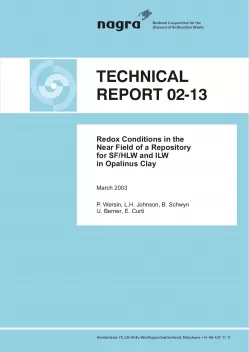
Technical Report NTB 02-13
Redox Conditions in the Near Field of a Repository for SF/HLW and ILW in Opalinus Clay
The description of redox conditions in the near field of a nuclear waste repository is an important but difficult aspect in performance assessment. Redox potentials are affected by both the thermodynamics and kinetics of relevant reactions, some of which are not adequately understood. This leads to considerable uncertainty of redox conditions in the repository environment and often to oversimplified terminology in performance assessment such as ‘reducing’ or ‘oxidising’. In this study we assess redox conditions by a holistic approach that considers all relevant sources of information. We apply this approach to the near field of the two types of repositories foreseen in the Swiss high-level waste programme: the spent fuel and highlevel waste (SF/HLW) and the intermediate-level waste (ILW) repositories. Although the environments surrounding these two waste streams are quite different, namely bentonite backfill versus cement, the procedures for describing redox conditions are similar. Thus, for both cases we first describe the layout of the repository and the properties of materials present in the near field. Then the duration of the initial oxic phase is estimated with the aid of limiting cases. The major part of this study focuses on the thermodynamic relationships and kinetic processes in the engineered barrier once oxygen has been depleted. Finally, from the combined set of information, reasonable ranges of long-term redox potentials are derived.
SF/HLW
After a relatively short initial oxic phase (< 100 a) the conditions in the bentonite backfill will become and remain reducing. The redox potentials will be largely influenced by the corrosion of steel, which will produce large amounts of magnetite, on the internal side of the bentonite barrier, and by the reducing conditions of the surrounding Opalinus Clay on the external side.
The derived Eh range of -100 mV to -300 mV (SHE) for the anoxic stage mainly reflects the relatively large uncertainties in the pH of the porewater. The calculations suggest that the uncertainty with regard to the nature of the Fe(III)-Fe(II) solid phases is less significant in determining the derived redox potentials. The calculated redox potentials are consistent with recent experimental data on the reduction behaviour of U(VI), Tc(VII) and Se(VI/IV).
The possible effect of high hydrogen pressures on redox potentials was not included in the analysis because the experimental data on the reactivity of H2(g) in bentonite are limited. This also holds for Fe(II)-rich silicate phases which may play a role at the canister - bentonite boundary, although significant effects on the redox potentials are not expected. Further experimental data on these systems would be useful for future performance assessments.
ILW
Heterogeneous reprocessed waste embedded in a cementitious matrix is grouped into two spatially separated waste types, ILW-1 and ILW-2. These two types consist of very different redox-sensitive materials and are assessed separately.
After relatively rapid depletion of residual oxygen the conditions in the ILW-1 repository will remain reducing. The redox potential will be largely influenced by steel corrosion producing thin magnetite-type films on steel surfaces. Based on Fe(III)/Fe(II) equilibria calculations, the derived redox potentials for the reducing stage are estimated to be between -750 and -230 mV (SHE). The redox conditions in ILW-2 are expected to be rather similar; however, they might be more oxidising if high nitrate concentrations persist over long time periods. In this case an upper Eh limit of +350 mV (SHE) is estimated.
The uncertainties with regard to the redox potentials in solution are large, mainly because of the lack of unequivocal experimental information on the phases forming during long-term corrosion of steels and the limited knowledge on iron-bearing cement phases. In addition, the importance of microbially-induced organic matter degradation, though considered to be of minor importance, is not adequately understood. If significant degradation occurs, lower redox potentials would be expected. This would also be the case if H2 produced by the corrosion process were more reactive than commonly assumed.
Further experimental work focussing on the steel corrosion under alkaline conditions and the identification of iron-bearing phases in the cement repository is needed to improve the understanding of the relevant redox processes. Also, the behaviour of redox- sensitive elements, such as U, Tc and Np in cementitious environments should be experimentally investigated.
